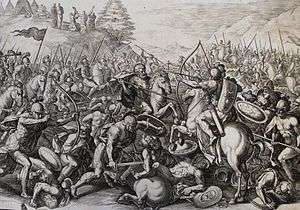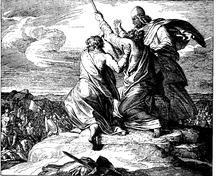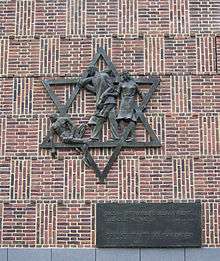Amalek
Amalek (Hebrew: עֲמָלֵק, Amaleq, Arabic: عماليق ‘Amālīq) is a nation described in the Hebrew Bible as an enemy of the Israelites. The name "Amalek" can refer to the nation's founder, a grandson of Esau; his descendants, the Amalekites; or the territories of Amalek which they inhabited.

Etymology
In some rabbinical interpretations, Amalek is etymologised as am lak, a people who lick (blood),[1] but most specialists regard the origin to be unknown.[2]
Amalekites in the Hebrew Bible
According to the Bible, Amalek was the son of Eliphaz (himself the son of Esau, ancestor of the Edomites) and Eliphaz's concubine Timna. Timna was a Horite and sister of Lotan.[3] Amalek is described as the "chief of Amalek" among the "chiefs of the sons of Esau",[4] from which it is surmised that he ruled a clan or territory named after him.
The Amalekite people were considered to be Amalek's descendants through the genealogy of Esau.[5] In the oracle of Balaam, Amalek was called the 'first of the nations'.[6] One modern scholar believes this attests to Amalek's high antiquity,[7] while traditional commentator Rashi states: "He came before all of them to make war with Israel".[8] First-century Roman-Jewish scholar and historian Flavius Josephus refers to Amalek as a 'bastard' (νόθος) in a derogatory sense.[9]

According to the Bible, the Amalekites inhabited the Negev.[10] They appear to have lived a nomadic or seminomadic lifestyle along the fringes of southern Canaan's agricultural zone.[11] This is probably based on the association of this tribal group with the steppe region of ancient Israel and the area of Kadesh (Genesis 14:7).
As a people, the Amalekites were identified as a recurrent enemy of the Israelites.[5] This role appears in several stories:
- In Exodus 17:8–16, Amalek makes war against Israel in the wilderness. Joshua is ordered by Moses to lead Israel in battle, and Moses watches from a hillside. When Moses' hand is raised, Israel prevails, but when it is lowered, Israel falters. So he keeps his hand raised through the entire battle, even having assistants hold him up, so that the battle will go to Israel.
- According to 1 Samuel 30:1–2, the Amalekites invaded the Negev and Ziklag in the Judean/Philistine border area towards the end of the reign of King Saul, burning Ziklag and taking its citizens away into captivity. The future king David led a successful mission against the Amalekites to recover "all that the Amalekites had carried away".[12]
- In 1 Samuel 15:1-9, Samuel identifies Amalek as the enemy of Israelites, saying "Thus says the Lord of hosts: I will punish Amalek for what he did to Israel, how he ambushed him on the way when he came up from Egypt. [13]. He then commands Saul to commit genocide against the Amalekites. [14]
- In 1 Samuel 15:33, Samuel identifies king Agag of Amalek as an enemy and killer, saying "As your sword has made women childless, so shall your mother be childless among women.”
- In 2 Samuel 1:5–10, an Amalekite tells David that he found Saul leaning on his spear after the battle of Gilboa. The Amalekite claims he euthanized Saul, at Saul's request, and removed his crown. [15] The intention behind the removal of the crown was for the Amalekite to present it to David, presumably to earn some kind of reward from him. David, however, condemns the Amalekite for killing the anointed king, using his own testimony as reference, and orders his men to execute him.[16]
Alternative theories of origins

In Genesis 14:7, the "field of the Amalekites" is mentioned, though the person Amalek had not yet been born.
Some commentators explain this as a reference to the territory which was later on inhabited by the Amalekites.[17] C. Knight elaborates this concept by making a comparison: one might say "Caesar went into France", though Gaul only later became known as France.[18]
Alternatively, during the Islamic Golden Age, certain Arabic writings claimed that the Amalekites existed long before Abraham.[19] Some Muslim historians claimed that the Amalekites who fought Joshua were descendants of the inhabitants of North Africa. Ebn Arabshah purported that Amalek was a descendant of Ham, son of Noah.[18][19] It is, however, possible that the name Amalek may have been given to two different nations. The Arabians mention Imlik, Amalik, or Ameleka among the aborigines of Arabia, the remains of which were mingled with the descendants of Joktan and Adnan and became Mostarabs or Mocarabes, that is, Arabians mixed with foreigners.[18]
By the 19th century, there was strong support by Western theologians for the idea that the nation of Amalek could have flourished before the time of Abraham. Matthew George Easton advocated that the Amalekites were not descendants of Amalek by taking a literal approach to Genesis 14:7.[20] However, the modern biblical scholar David Freedman uses textual analysis to glean that the use of Amalekite in Genesis 14:7 is actually an anachronism,[11] and in the early 19th century, Richard Watson enumerated several speculative reasons for having a "more ancient Amalek" than Abraham.[19]
In the exegesis of Numbers 24:20 concerning Balaam's utterance: "Amalek was the first one of the nations, but his end afterward will be even his perishing", Richard Watson attempts to associate this passage to the "first one of the nations" that developed post-Flood.[19] According to Samuel Cox, the Amalekites were the "first" in their hostility toward the Israelites.[21]
Historicity
Although Egyptian and Assyrian monumental inscriptions and records of the period survive which list various tribes and peoples of the area, no reference has ever been found to Amalek or the Amalekites. Therefore, the archaeologist and historian Hugo Winckler suggested in 1895 that there were never any such people and the Biblical stories concerning them are entirely mythological and ahistorical.[22] While considerable knowledge about nomadic Arabs has been recovered through archeological research, no specific artifacts or sites have been linked to Amalek with any certainty.[11] However, it is possible that some of the fortified settlements in the Negev highlands and even Tel Masos (near Beer-sheba) have Amalek connections.[23] Easton claims that the Babylonian inscription Sute and the Egyptian term Sittiu refer to the Amalekites. Easton also claims that the Amarna tablets refer to the Amalekites under the general name Khabbatti, or "plunderers".[20]
Jewish traditions

According to a midrash, Amalek's mother Timna was a princess who had tried to convert to Judaism but had been rejected by Abraham, Isaac and Jacob. She replied she would rather be a handmaiden to the dregs of this nation then be the mistress of another Nation; to punish the Patriarchs for the affront they had made her, she was made the mother of Amalek which would cause Israel much distress.[24][25]
According to the Midrash, the Amalekites were sorcerers who could transform themselves to resemble animals, in order to avoid capture. Thus, in 1 Samuel 15:3, it was considered necessary to destroy the livestock in order to destroy Amalek.[26]
In Judaism, the Amalekites came to represent the archetypal enemy of the Jews. In Jewish folklore the Amalekites are considered to be the symbol of evil.
Nur Masalha, Elliot Horowitz and Josef Stern suggest that Amalekites have come to represent an "eternally irreconcilable enemy" that wants to murder Jews, and that Jews in post-biblical times sometimes associate contemporary enemies with Haman or Amalekites, and that some Jews believe that pre-emptive violence is acceptable against such enemies.[27] Groups identified with Amalek include the Romans, Nazis, Stalinists, and bellicose Iranian leaders such as Mahmoud Ahmadinejad.[28]
More metaphorically, to some Hasidic rabbis (particularly the Baal Shem Tov), Amalek represents atheism or the rejection of God.
During the Purim festival, the Book of Esther is read in the commemoration of the saving of the Jewish people from Haman (considered to be an Amalekite) who leads a plot to kill the Jews. On the basis of Exodus 17:14, where the Lord promised to "blot out the name" of Amalek, it is customary for the audience to make noise and shout whenever "Haman" is mentioned, in order to desecrate his name. It is customary to recite Deuteronomy 25:17–18 (see below) on the Shabbat before Purim.[29]
Commandment to exterminate the Amalekites
Commandments
In Orthodox Judaism, three of the 613 mitzvot (commandments) involve Amalek: to remember what the Amalekites did to the Israelites, not to forget what the Amalekites did to Israelites, and to destroy the Amalekites utterly. The rabbis derived these from Deuteronomy 25:17–18, Exodus 17:14 and 1 Samuel 15:3. Rashi explains the third commandment:
From man unto woman, from infant unto suckling, from ox unto sheep, so that the name of Amalek not be mentioned even with reference to an animal by saying "This animal belonged to Amalek".
As enumerated by Maimonides, the three mitzvot state:
598 Deut. 25:17 – Remember what Amalek did to the Israelites
599 Deut. 25:19 – Wipe out the descendants of Amalek
600 Deut. 25:19 – Not to forget Amalek's atrocities and ambush on our journey from Egypt in the desert
Some commentators have discussed the ethical deficiency of the commandment to exterminate all the Amalekites, especially including the command to kill children, and the presumption of collective punishment.[30][31][32][33]
Limitations
The commandment to kill Amalekites is not practiced by contemporary Jews, based on the argument that Sennacherib deported and mixed the nations, so it is no longer possible to determine who is an Amalekite. For example, Rabbi Hayim Palaggi stated:
We can rely on the maxim that in ancient times, Sennacherib confused the lineage of many nations.[34]
In addition, many rabbinic authorities ruled that the commandment only applies to a Jewish king or organized community, and cannot be performed by an individual.[35] According to Haggahot Maimuniyyot the commandment only applies in the future messianic era, and not in present times; this limitation is almost a consensus among medieval authorities.[36]
Maimonides explains that the commandment to destroy the nation of Amalek requires the Jewish people to peacefully request that they accept upon themselves the Seven Laws of Noah and pay a tax to the Jewish kingdom. Only if they refuse must they be physically killed.[37]
A few authorities have ruled that the command never included killing Amalekites. R' Samson Raphael Hirsch said that the command was to destroy "the remembrance of Amalek" rather than actual Amalekites;[38] the Sfat Emet said that the command was to fully hate Amalek rather than performing any action;[39] and the Chofetz Chaim said that God would perform the elimination of Amalek and Jews are only commanded to remember what Amalek did to them.[40]
See also
Footnotes
- David Patterson, A Genealogy of Evil: Anti-Semitism from Nazism to Islamic Jihad, Cambridge University Press, 2011, pp.43,244.
- M. Weippert, Semitische Nomaden des zweiten Jahrtausends. Biblica vol. 55, 1974, 265-280, 427-433
- Book of Genesis 36:12; 1 Chronicles 1:36
- Genesis 36:16
- Mercer Dictionary 1990, p. 21.
- At Numbers 24:20
- J. Macpherson, 'Amalek' in James Hastings, (ed.) A Dictionary of the Bible: Volume I (Part I: A -- Cyrus), University Press of the Pacific, Honolulu, (1898) 2004, pp.77-79, p.77.
- Rashi
- Louis H. Feldman, "Remember Amalek!": Vengeance, Zealotry, and Group Destruction in the Bible According to Philo, Pseudo-Philo, and Josephus '"Remember Amalek!": Vengeance, Zealotry, and Group Destruction in the Bible According to Philo, Pseudo-Philo, and Josephus,] Hebrew Union College Press, 2004 pp.8-9
- Numbers 13:29
- Eerdmans 2000, p. 48.
- 1 Samuel 30:9–20
- 2 Samuel 15:2
- 2 Samuel 15:3
- 2 Samuel 1:6-10
- 2 Samuel 1:16
- Including Rashi
- Knight 1833, p. 411.
- Watson 1832, p. 50.
- Easton 1894, p. 35, Am'alekite.
- Cox 1884, p. 125-126.
- Singer, Isidore (1901). The Jewish encyclopedia: a descriptive record of the history, religion, literature, and customs of the Jewish people from the earliest times to the present day (2004 reprint ed.). Cornell University Library. ISBN 978-1112115349.
- Eerdmans 2000, p. 49.
- Louis Ginzberg The Legends of the Jews pp.422-423
- For an Rabbanic explanation of Timna lineage see Timna, concubine of Eliphaz: Midrash and Aggadah
- Rashi, 1 Samuel 15:3 commentary, The Rubin Edition, ISBN 1-57819-333-8, p. 93
-
- Masalha, Nur, Imperial Israel and the Palestinians: the politics of expansion, Pluto Press, 2000, pp 129–131.
- Stern, Josef, "Maimonides on Amalek, Self-Corrective Mechanisms, and the War against Idolatry" in Judaism and modernity: the religious philosophy of David Hartman, David Hartman, Jonathan W. Malino (Eds), Ashgate Publishing, Ltd., 2004 pp 360–362
- Hunter, Alastair G. "Denominating Amalek: Racist stereotyping in the Bible and the Justification of Discrimination" in Sanctified aggression: legacies of biblical and post-biblical vocabularies, Jonneke Bekkenkamp, Yvonne Sherwood (Eds), Continuum International Publishing Group, 2003, p 99–105.
- Roth, Daniel. "Shabbat Zachor: "Remember what Amalek did to you!" But why did he do it? Can we reconcile with our eternal sworn enemies?" Pardes from Jerusalem, 18 Feb. 2018. Elmad by Pardes.
- Finley, Mordecai. "Unmasking Purim, Fighting Amalek: Behind the whimsy of this holiday lie some deep lessons for living." Jewish Journal. 21 February 2018. 22 February 2018.
- Harris, Michael J. Divine Command Ethics: Jewish and Christian perspectives. pp. 137–138.
- Elkins, Dov Peretz; Treu, Abigail. The Bible's Top Fifty Ideas: The essential concepts everyone should know. pp. 315–316.
- Richard Sorabji; Rodin, David. The Ethics of War: Shared problems in different traditions. p. 98.
- Rogerson, John William; Carroll, M. Daniel. Theory and Practice in Old Testament Ethics. p. 92.
- Eynei Kol Ḥai, 73, on Sanhedrin 96b. Also Minchat Chinuch, parshat Ki Tetze, mitzvah 434.
- Maimonides (Sefer Hamitzvot, end of positive commandments), Nachmanides (Commentary to Exodus 17:16), Sefer HaYereim (435), Hagahot Maimoniyot (Hilchot Melachim 5:5)
- Aryeh Klapper, How Not to Talk About Amalek
- Mishneh Torah, Hilchot Melachim uMilchamot, 6:1 and 6:6-7
- Commentary to Deuteronomy 25
- Shemot Zachor 646
- Introduction to positive commandments, Beer Mayim Hayim, letter Alef
References
- Cox, Samuel (1884). Balaam: An Exposition and a Study. London: K. Paul, Trench, & Company. p. 125.CS1 maint: ref=harv (link)
- Easton, Matthew George (1894). Illustrated Bible Dictionary (2nd ed.). London: T. Nelson.CS1 maint: ref=harv (link)
- Feldman, Louis H (2004). Remember Amalek!: Vengeance, Zealotry, and Group Destruction in the Bible according to Philo, Pseudo-Philo, and Josephus. Hebrew Union College Press. ISBN 0878204636.CS1 maint: ref=harv (link)
- Freedman, David Noel (2000). Eerdmans Dictionary of the Bible (David Noel Freedman, Allen C. Myers, Astrid B. Beck ed.). Wm. B. Eerdmans Publishing. ISBN 9780802824004.CS1 maint: ref=harv (link)
- Knight, Charles (1833). Penny Cyclopaedia, Volumes 1-2. Great Britain.CS1 maint: ref=harv (link)
- Mills, Watson E.; associate editor, Roger Bullard (1997). Mercer Dictionary of the Bible (3rd and corr. print. ed.). Macon, Ga.: Mercer University Press. ISBN 9780865543737.CS1 maint: ref=harv (link)
- Sagi, Avi (1994). The Punishment of Amalek in Jewish Tradition: Coping with the Moral Problem, Harvard Theological Review Vol.87, No.3, p. 323-46.
- Watson, Richard (1832). A Biblical and theological dictionary. London: John Mason.CS1 maint: ref=harv (link)
External links
| Wikimedia Commons has media related to Amalek. |
- Wipe Out Amalek, Today? chabad.org
- Amalek, Based on the teachings of the Lubavitcher Rebbe
- Remember Amalek: A lesson in Divine Providence
- Remembering Amalek
- Latznu: Popular Culture and the Disciples of Amalek
- Antiquities of the Jews - by Josephus Flavius
- The Jewish Encyclopedia, 1901-6: Amalek
- A Kabbalistic view of Amalek
- Amalec - Catholic Encyclopedia article
- Between Rephidim and Jerusalem - Amalek symbolism in relations between Israelis and Palestinians
- Contemporary Amalek - Hirhurim - a blog post by Rabbi Gil Student explaining Rav Soloveitchik's controversial view that the Nazis were considered Amalekites